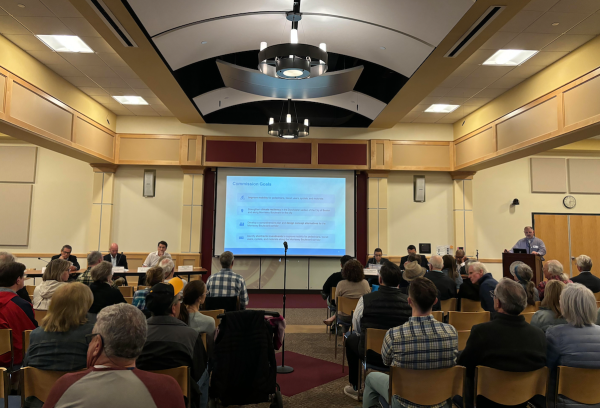May 3, 2024

A view of the Morrissey Commission meeting held at BC High on Thurs., May 2. Taylor Brokesh photo
A range of options for re-designing the Morrissey Boulevard corridor were presented at a public meeting of the Morrissey Boulevard Commission last Thursday night (May 2) at Boston College High School in front of a crowd of roughly 70 people, with another 50 participating virtually.
The Morrissey Commission was formed by state law last year to devise a plan to rehabilitate Morrissey Boulevard and Kosciuszko Circle that emphasizes climate resilience and safety for all users while fostering a stronger sense of community. The plans were split into three zones: the north zone, from South Boston’s Preble Circle to Bianculli Boulevard at the entrance to UMass Boston; the central zone, from Bianculli Boulevard to Freeport Street; and the south zone, from Freeport Street to Neponset Circle.
The major focus of the central zone is to improve flood resistance, while other infrastructure improvements are the focus of the north and south zones. Some of those changes revolved include re-configured intersections to better handle traffic patterns and, notably, reducing the roadway’s existing three lanes to two to accommodate bike lanes, or even center bus lanes in certain sections of the roadway. For the central zone, potential options include adding a tide gate, raising the road by at least six feet, and creating a sloped natural berm to serve as a flood wall, though how high that may be has not been discussed.
Mayor Wu, who has appointees serving on the commission, including Arthur Jemison, director of the Boston Planning and Development Agency (BPDA), has called on state officials to make sure Kosciuszko Circle is included in the commission’s scope. In a section of Thursday’s presentation, the circle was discussed briefly, with MassDOT officials noting that a separate project is underway to study the rotary and related I-93 exchanges. In a slide shown at the meeting, MassDOT said it is “targeting Fall of 2024 to present the deficiencies and potential concepts for the public to offer opinion.”
Jake Wachman, state Sen. Nick Collins’ designee on the commission and chair of the Columbia-Savin Hill Civic Association’s government affairs committee, made a motion to “extend the commission for an indeterminate period of time” after the presentation concluded and commissioners were able to give their thoughts.
“We’ve got to have the time to get this right,” Wachman said. “I feel like MassDOT’s usual way of doing things is running up against the law and the reason why this commission was created.”
Wachman’s motion, seconded by former city councillor Frank Baker, was not officially adopted, but most commissioners in attendance seemed to agree that more time would be necessary to finalize granular plans.
State Rep. Dan Hunt, a member of the commission as well, urged the audience to keep in mind the legislation that created the commission. “I think we’re getting a little bit ahead of ourselves as far as the rules that exist within our use,” he said. “I believe that the secretary [of Transportation] is committed to a fourth meeting, and that, if needed, Sen. Collins and I, along with [Rep.] David Biele, who created this legislation, could simply extend it out.”
The legislation directed the commission to complete its work by June 2024, a deadline that the group itself highlighted in its first meeting last November.
There were other concerns raised by commissioners besides the timeline. City Councillor John FitzGerald voiced his reservations about the removal of a third vehicular lane in each direction to accommodate dedicated bike lanes. Instead, he suggested the bike lanes be situated on top of the natural berm area. Earlier attempts to re-engineer Morrissey Boulevard, including an earlier public process led by the Dept. of Conservation and Recreation, were stalled to inaction in 2017, in large part because of disagreements over the travel lane issue.
Jemison, the BPDA director, suggested that work begin as soon as possible on the smaller-scale aspects of the project so that some of the current-day problems along the corridor could be alleviated.
Some attendees raised concerns about specific elements of the emerging plan, while others questioned the necessity of bike lanes and more family-friendly natural areas if, as one community member put it, “families can’t even afford to live here.”
Don Walsh of the Columbia-Savin Hill Civic Association stressed the importance of considering the impact of an estimated 10,000 new housing units that are expected to be added to the corridor and nearby neighborhoods— and how that will impact traffic flows.
By the meeting’s end, much remained unclear, including when the next meeting would be held. The commission originally set forth a plan to hold four public meetings prior to the June deadline. Councillor FitzGerald advocated for a “meeting 3.5” to be held, perhaps on a smaller scale among local civic associations and members of the commission, but nothing has yet been announced.
MassDOT also proposed several methods of “City of Boston Public Engagement” to discuss the project details further, including community walks, chats with planners, and in-person and virtual office hours.
Further information about the project and future events related to the commission can be found at mass.gov/k-circle-morrissey-study.
Topics:
Tags:


